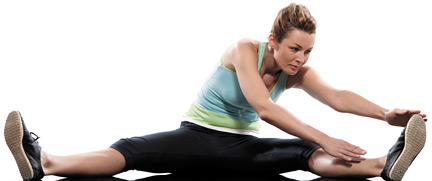Which Stretch Is Best?
Traditionally, stretching routines have followed the principle of static holding; that means holding a stretch in a single position for 20-30 seconds or more.
These types of stretches, known as
static stretches, were the only stretches in town for years. Of late, experts in the fitness world increasingly question whether static stretching, particularly
before running or performing a sport, has value. In fact, they theorize that static stretching may actually increase injury risk if performed before participating in an activity.
The reason for this concern is because when your muscles are cold, they're at their most stiff. That makes perfect sense, right? Again, picture yourself heading out for a run – without warming up your body – after spending a sedentary day at your desk at work and another hour in your car coming home. Static stretching could actually overstretch the muscle, straining or tearing it.
The solution, according to more and more experts, is to warm up first, complete your physical activity (say, a run) and then perform static stretches, when your body can handle it. The bottom line is that cold muscles are much easier to injure than warm muscles; applying a prolonged, static stretch before you're adequately warmed up could do more damage than good.
So, does that mean you shouldn't stretch before an activity? Of course not. But you might not want to do static stretches. Instead, try dynamic active stretches – things like knee lifts, arm circles, walking lunges, leg swings, torso twists, etc. Think of dynamic stretches as a way to warm up your body in a gentle fashion that prepares you for your activity. Rather than holding a single area of the body in a stretched position for 30 seconds or more, you're stretching multiple muscles and muscle groups by way of continuous movement.
The best way to view static versus dynamic stretching is in terms of motion: When performing a static stretch, you're essentially holding a stretch in one position for a certain length of time, stretching one particular muscle or muscle group (e.g., the calf). When performing a dynamic (active) stretch, you're still stretching the calf muscle(s), but only for a few seconds at a time, and you're not really "holding" it in one place. And doing lunges, for example, doesn't just stretch the calf muscles, but also the lower leg, upper leg, hips, glutes and lower back.
Stretch Your Limits
Is a consistent stretching routine missing from your life? If it is, you're putting your health at risk. Remember, stretching isn't just for athletes; it's for everyone - that means you! Talk to your doctor about the benefits of stretching and how to properly perform static and dynamic stretches to maximize flexibility and reduce injury risk for a lifetime.


